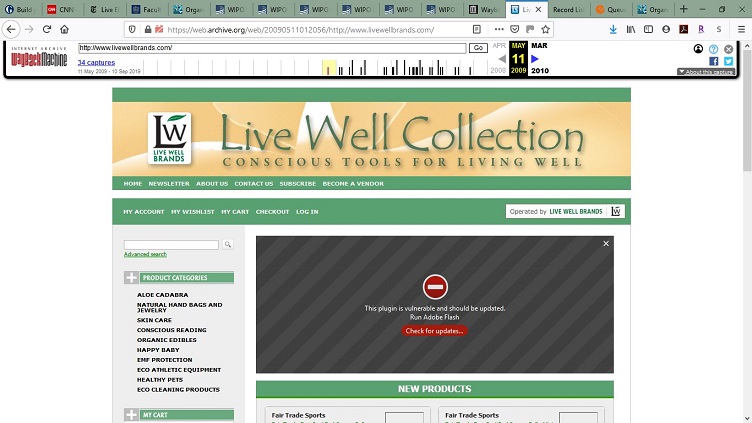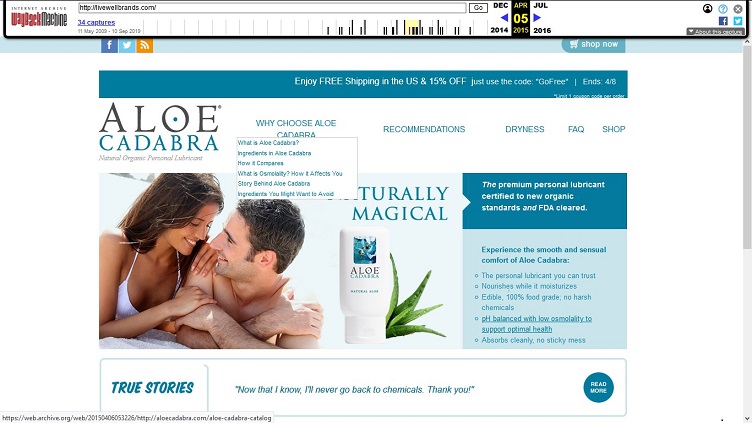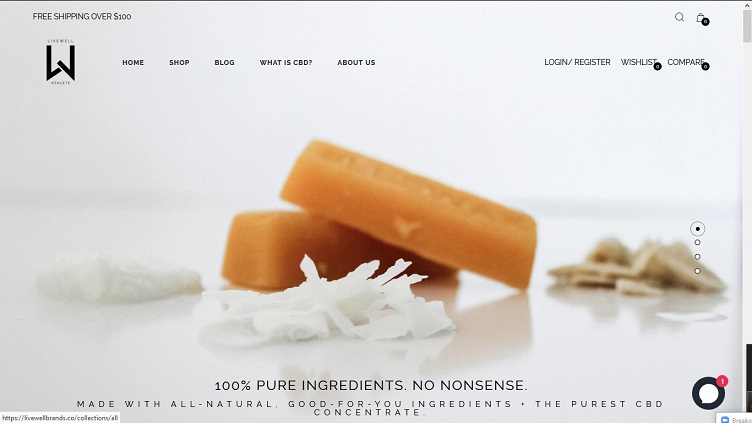WIPO Arbitration and Mediation Center
ADMINISTRATIVE PANEL DECISION
Live Life Well Brands, Inc. v. Registration Private, Domains By Proxy, LLC / Daniel Sentenac
Case No. DCO2020-0049
1. The Parties
Complainant is Live Life Well Brands, Inc., United States of America (“U.S.”), represented by Burns & Levinson LLP, U.S.
Respondent is Registration Private, Domains By Proxy, LLC, U.S. / Daniel Sentenac, U.S.
2. The Domain Name and Registrar
The disputed domain name <livewellbrands.co> (the “Domain Name”) is registered with GoDaddy.com, LLC (the “Registrar”).
3. Procedural History
The Complaint was filed with the WIPO Arbitration and Mediation Center (the “Center”) on August 25, 2020. On August 26, 2020, the Center transmitted by email to the Registrar a request for registrar verification in connection with the Domain Name. On August 27, 2020, the Registrar transmitted by email to the Center its verification response disclosing registrant and contact information for the Domain Name, which differed from the named Respondent and contact information in the Complaint. The Center sent an email communication to Complainant on September 8, 2020, providing the registrant and contact information disclosed by the Registrar, and inviting Complainant to submit an amendment to the Complaint. Complainant filed an amendment to the Complaint on September 9, 2020. The Center received an informal email from Respondent on September 9, 2020 stating: “The complainant does not own intellectual property nor a trademark on this domain.” The Center received no further communications from Respondent.
The Center verified that the Complaint together with the amendment to the Complaint satisfied the formal requirements of the Uniform Domain Name Dispute Resolution Policy (the “Policy” or “UDRP”), the Rules for Uniform Domain Name Dispute Resolution Policy (the “Rules”), and the WIPO Supplemental Rules for Uniform Domain Name Dispute Resolution Policy (the “Supplemental Rules”).
In accordance with the Rules, paragraphs 2 and 4, the Center formally notified Respondent of the Complaint, and the proceedings commenced on September 23, 2020. In accordance with the Rules, paragraph 5, the due date for Response was October 13, 2020. Respondent did not submit a response. Accordingly, the Center notified the Parties of the commencement of Panel appointment on October 16, 2020.
The Center appointed Christopher S. Gibson as the sole panelist in this matter on October 21, 2020. The Panel finds that it was properly constituted. The Panel has submitted the Statement of Acceptance and Declaration of Impartiality and Independence, as required by the Center to ensure compliance with the Rules, paragraph 7.
4. Factual Background
Complainant produces a variety of wellness products. Complainant states it has operated its business and advertised its goods under the trademark LIVE WELL BRANDS since as early as December 2009. Complainant has submitted a copy of its California Certificate of Registration showing the date of incorporation as March 28, 2007.
Complainant established a website located at “www.livewellbrands.com”. Complainant states that the website has been used since 2009 to promote its goods, and features the LIVE WELL BRANDS mark at the footer of the home page and throughout site. Complainant has submitted printouts of the current homepage for its website, along with the homepage of the website as crawled by the Internet Archive on May 11, 2009.
To understand the factual background and assess the merits in this case, the Panel has conducted certain online searches, including visiting Complainant’s and Respondent’s respective websites, using the Internet Archive WayBack Machine, and searching for trademarks using the United States Patent and Trademark (“USPTO”) Electronic Search System, in accordance with paragraphs 10 and 12 of the Rules. In this regard, WIPO Overview of WIPO Panel Views on Selected UDRP Questions, Third Edition (“WIPO Overview 3.0”), section 4.8, provides in relevant part:
“Noting in particular the general powers of a panel articulated inter alia in paragraphs 10 and 12 of the UDRP Rules, it has been accepted that a panel may undertake limited factual research into matters of public record if it would consider such information useful to assessing the case merits and reaching a decision.
This may include visiting the website linked to the disputed domain name in order to obtain more information about the respondent or its use of the domain name, consulting historical resources such as the Internet Archive (www.archive.org) in order to obtain an indication of how a domain name may have been used in the relevant past, reviewing dictionaries or encyclopedias (e.g., Wikipedia), or accessing trademark registration databases.”
These online searches have disclosed the following information:
(i) Complainant’s website: Complainant’s website at “www.livewellbrands.com” currently brings up the following error message:
“404
The site you were looking for couldn't be found.
This domain is successfully pointed at WP Engine, but is not configured for an account on our platform.”
A review of Complainant’s website at “www.livewellbrands.com”, as crawled by the Internet Archive’s WayBack Machine, shows that beginning as early as May 11, 2009 Complainant operated a website branded with the LIVE WELL BRANDS mark, as shown by the screenshot below:

The Internet Archive WayBack Machine further indicates that this branding for the website remained consistent for more than 5 years, until at least December 19, 2014. Sometime after that date, but before April 5, 2015, Complainant shifted the branding of its site to focus on the brand of one of its products, Aloe Cadabra, as shown by the screenshot below:

This version of the website, with the Aloe Cadabra brand prominently featured, seems to have remained in place until at least November 2018. In addition, beginning in 2015, as indicated by Complainant, the homepage of Complainant’s website presented a footer as follows, with the referenced year updated annually thereafter: “©2015 Live Well Brands, Inc. - All Rights Reserved”.
As of September 10, 2019, the Internet Archive WayBack Machine indicates that Complainant’s domain name, <livewellbrands.com>, began redirecting to a website at <aloecadabra.com> as indicated below:
“Loading...
http://livewellbrands.com/ |
19:35:46 September 10, 2019
Got an HTTP 301 response at crawl time
Redirecting to...
https://aloecadabra.com/.”
(ii) Complainant’s Trademark Applications: Complainant submitted two trademark applications on August 29, 2018, serial Nos. 88097781 and 88976575, for the word marks LIVE WELL BRANDS. Each application states: “No claim is made to the exclusive right to use ‘BRANDS’ apart from the mark as shown.” Application No. 88976575 indicates three different dates of “first use in commerce” in relation to the various products covered:
- Vaginal moisturizers; personal lubricant, namely, vaginal lubricant; medicated ointment for moisturizing, soothing and addressing vaginal and anal issues. FIRST USE IN COMMERCE: May 11, 2009.
- Applicators for use with vaginal creams and lubricants, sold separately. FIRST USE IN COMMERCE: November 28, 2015.
- Massage oil; body oil. FIRST USE IN COMMERCE: August 8, 2018.
(iii) The Domain Name and Respondent’s website:
The Domain Name was registered on August 9, 2018. As of the filing date of the Complaint, the Domain Name resolved to a website where Respondent offers Cannabidiol (“CBD”) based products. A screenshot of the website is provided below:

5. Parties’ Contentions
A. Complainant
(i) Identical or confusingly similar.
Complainant contends that it owns exclusive rights in its LIVE WELL BRANDS trademark and that through extensive use and promotional activities using the mark since as early as 2009, the mark has become a distinctive identifier, which consumers associate with Complainant’s wellness products.
Complainant has submitted a declaration, signed under penalty of perjury, by its Vice President to the effect that Complainant has used and promoted the LIVE WELL BRANDS mark in the U.S. for approximately eleven years and that no other individual or entity is permitted to use Complainant’s trademark without authorization or license. The Vice President states that Complainant uses the LIVE WELL BRANDS mark ubiquitously on its various wellness products, as well as on its website, and that the mark has become distinctive and is well recognized across many industries as uniquely associated with Complainant’s goods, serving to distinguish them from those of its competitors. Complainant states that consumers have come to recognize LIVE WELL BRANDS as identifying quality products sourced from Complainant.
Complainant claims that the sworn declaration of its Vice President is sufficient for establishing Complainant’s significant common law trademark rights in the LIVE WELL BRANDS mark for the purposes of paragraph 4(a)(i) of the Policy. Moreover, Complainant state that its use of a website at “www.livewellbrands.com” has featured the mark for over ten years and establishes the basis for its exclusive rights.
Complainant states the Domain Name incorporates the entirety of the LIVE WELL BRANDS mark, while adding only the “.co” country code Top-Level Domain (“ccTLD”), making it confusingly similar, if not identical, to Complainant’s mark.
In sum, Complainant claims that it owns valid common law trademark rights in its LIVE WELL BRANDS mark, that the Domain Name is identical or confusingly similar to the mark, and that Respondent’s use is intended to impersonate Complainant and to intercept and confuse consumers when looking for bona fide goods from Complainant.
(ii) Rights or legitimate interests.
Complainant states it has not authorized Respondent’s use of the LIVE WELL BRANDS mark or the registration of the Domain Name. This unauthorized use of the Domain Name by Respondent severely harms Complainant by tarnishing and infringing its trademarks, reputation and goodwill in the U.S. and around the world. In particular, Complainant contends its reputation is being severely harmed by the association of the LIVE WELL BRANDS mark with cannabis/CBD products, which carry a negative connotation.
Further, Complainant asserts there is no indication that Respondent has used the Domain Name in connection with any legitimate noncommercial or fair use of Complainant’s trademark, all of which establishes a prima facie case that Respondent has no rights or legitimate interests in respect of the Domain Name. Respondent has no connection or affiliation with Complainant and has not received any license or consent, express or implied, to use the mark in a domain name or in any other manner. Furthermore, Complainant believes that Respondent was not commonly known by the Domain Name at the time of registration.
In light of the foregoing, Complainant contends that Respondent has no right or legitimate interest in the Domain Name, since it is not a name that Respondent would have legitimately and randomly chosen to use.
(iii) Registered and used in bad faith.
Complainant contends that Respondent registered the Domain Name in bad faith by doing so with knowledge of Complainant’s rights in Complainant’s LIVE WELL BRANDS mark and with an intent to profit off those rights. Complainant urges it is inconceivable that Respondent was unaware of Complainant’s rights in the mark when it registered the Domain Name that incorporates Complainant’s well-known mark in its entirety. At a minimum, Respondent had actual notice of Complainant’s rights – even a simple Internet search would have revealed Complainant’s extensive use of the mark as a source identifier.
Complainant asserts that Respondent’s use of the mark to attract Internet users to Respondent’s website, knowing that Complainant had not authorized it to do so, is evidence of bad faith. Respondent must have expected that any use of the Domain Name would cause harm to Complainant. Complainant states the Domain Name – wholly incorporating the mark – is so obviously indicative of being authorized by Complainant that Respondent’s use of the Domain Name would inevitably lead to confusion of some sort.
Complainant urges that Respondent’s use of the Domain Name supports a finding of bad faith and that there is no conceivable use of the Domain Name that would not be an infringing use by Respondent. As such, it is currently being used in bad faith in violation of the Policy.
B. Respondent
Respondent did not reply to Complainant’s contentions. As noted above, Respondent submitted an informal email on September 9, 2020, stating: “The complainant does not own intellectual property nor a trademark on this domain.”
6. Discussion and Findings
In order to succeed on its Complaint, Complainant must demonstrate that the three elements set forth in paragraph 4(a) of the Policy have been satisfied. These elements are that:
(i) the Domain Name registered by Respondent is identical or confusingly similar to a trademark or service mark in which Complainant has rights;
(ii) Respondent has no rights to or legitimate interests in respect of the Domain Name; and
(iii) Respondent has registered and is using the Domain Name in bad faith.
A. Identical or Confusingly Similar
Complainant must establish that it has rights in a trademark that are sufficient for the purposes of paragraph 4(a)(i) of the Policy, and that the Domain Name is identical or confusingly similar to the mark.
Complainant claims that the sworn declaration of its Vice President, along with the website at “www.livewellbrands.com” featuring the LIVE WELL BRANDS mark, is sufficient for establishing Complainant’s common law trademark rights. The Panel observes that previous UDRP panels have found complainants to have common law trademark rights sufficient to satisfy the degree of trademark ownership required under the Policy. In this regard, WIPO Overview 3.0, section 1.3, provides in relevant part:
“To establish unregistered or common law trademark rights for purposes of the UDRP, the complainant must show that its mark has become a distinctive identifier which consumers associate with the complainant’s goods and/or services.
Relevant evidence demonstrating such acquired distinctiveness (also referred to as secondary meaning) includes a range of factors such as (i) the duration and nature of use of the mark, (ii) the amount of sales under the mark, (iii) the nature and extent of advertising using the mark, (iv) the degree of actual public (e.g., consumer, industry, media) recognition, and (v) consumer surveys).
Specific evidence supporting assertions of acquired distinctiveness should be included in the complaint; conclusory allegations of unregistered or common law rights, even if undisputed in the particular UDRP case, would not normally suffice to show secondary meaning. In cases involving unregistered or common law marks that are comprised solely of descriptive terms which are not inherently distinctive, there is a greater onus on the complainant to present evidence of acquired distinctiveness/secondary meaning.”
Further, section 1.3 of WIPO Overview 3.0 further provides that:
“Even where a panel finds that a complainant has UDRP standing based on unregistered or common law trademark rights, the strength of the complainant’s mark may be considered relevant in evaluating the second and third elements.”
In this case, where Respondent has failed to respond to Complainant’s allegations and evidence, the Panel determines that the evidence submitted by Complainant is sufficient to establish common law rights in its LIVE WELL BRANDS mark. However, the case presents a close call, especially because (i) the LIVE WELL BRANDS mark is comprised of largely descriptive terms that are not inherently distinctive, and (ii) the evidence submitted by Complainant in this proceeding is limited.
Complainant does not have an existing trademark registration for its LIVE WELL BRANDS trademark, but the Panel’s search of the USPTO database reveals that Complainant does have two pending applications for this mark dated August 29, 2018, with one claiming a date of first use in commerce of May 11, 2009. Complainant also submitted a copy of its California Certificate of Registration showing its date of incorporation as March 28, 2007. Moreover, the sworn declaration of Complainant’s Vice President states that the LIVE WELL BRANDS mark has been used for approximately eleven years, including on Complainant’s various wellness products and its website. Complainant provided no other evidence in support of use of the mark on Complainant’s specific products. The Panel’s own review shows that the LIVE WELL BRANDS mark was featured on Complainant’s website for more than five years from May 2009 until December 2014, but that sometime after that date and before April 5, 2015, Complainant appears to have shifted the branding of its website to focus on the brand of one of its products, Aloe Cadabra. Moreover, sometime prior to September 2019, Complainant’s website at “www.livewellbrands.com” started re-directing to a site at <aloecadabra.com>. Currently, the site at “www.livewellbrands.com” does not appear to be active. Instead, Complainant appears to maintain a website at “www.aloecadabra.com”. Thus, it is unclear how much prominence and continuing focus Complainant has given to its LIVE WELL BRANDS mark.
The Panel nevertheless finds, by a slight preponderance, that it is more likely than not that Complainant has established common law rights in its LIVE WELL BRANDS mark at least for purposes of this proceeding moving forward, based on the uncontested sworn declaration of Complainant’s Vice President concerning prior use of the mark, as well as the previous versions of Complainant’s website featuring mark and Complainant’s continuing use of the mark, e.g., on the active website at <aloecadabra.com>, which contains a footer referencing “©2020 Live Well Brands, Inc. – All Rights Reserved”. See Yellow Fiber Networks, Inc. v. Yellow Fiber Networks Limited, WIPO Case No. D2013-1173 (finding complainant had established common law trademark rights based on a sworn declaration as to use of its trademarks for approximately six years); Sherwood Tractor Inc. v. Nathan Pruss / Tyler Toney, Bruno’s Powersports, WIPO Case No. D2018-2337 (use of trademark on website for less than three years accepted as evidence of complainant’s common law trademark rights).
The Panel further determines that the Domain Name is identical to the LIVE WELL BRANDS mark, except for the “.co” ccTLD.
Accordingly, the Panel finds that that the Domain Name is identical to a trademark in which Complainant has rights in accordance with paragraph 4(a)(i) of the Policy.
B. Rights or Legitimate Interests
Regarding the second element of the Policy, Complainant has stated that it did not authorize Respondent to use its LIVE WELL BRANDS mark in a domain name. Moreover, Complainant contends that Respondent has not used the Domain Name in connection with any legitimate noncommercial or fair use, that Respondent was not commonly known by the Domain Name at the time of registration, and that the Domain Name does not correspond to a name Respondent would have legitimately and randomly chosen to use.
Pursuant to paragraph 4(c)(i) of the Policy, a respondent may establish rights or legitimate interests in a domain name by showing, among other circumstances, that before any notice of the dispute, the respondent used, or made demonstrable preparations to use, the domain name (or a name corresponding to it) in connection with a bona fide offering of goods or services. Here, Respondent has failed to submit a response, except for its email contending that Complainant “does not own intellectual property nor a trademark on this domain”. Despite Respondent’s meagre reply, the Panel observes that the Domain Name in this case resolves to a website at “www.livewellbrands.co”, where it appears to be used in connection with a bona fide business. Respondent offers CBD-related products for sale, including gummies, capsules, dog biscuits and salve with certain essential oils, including CBD oil. In addition and importantly, the design of Respondent’s website and its mark (see below) bear no resemblance to Complainant’s past or present website or to Complainant’s LIVE WELL BRANDS mark.
Respondent’s mark:

The Panel finds from this evidence that Respondent appears to operate a bona fide company. Thus, a key question is whether there is evidence that Respondent targeted Complainant and its LIVE WELL BRANDS marks when registering the Domain Name and when using it thereafter. If such evidence exists, it would undercut any claim to a right or legitimate interest in the Domain Name.
As to this point, the Panel finds that – despite Complainant’s allegations that it is inconceivable Respondent was unaware of Complainant’s rights in the LIVE WELL BRANDS mark when registering the Domain Name – Complainant has presented insufficient evidence to support this allegation. The Domain Name was registered on August 9, 2018, exactly 20 days before Complainant filed its trademark applications. Thus, a search of the USPTO website at that time would not have revealed any potential rights on the part of Complainant. Moreover, it is unclear whether a general Internet search for Complainant or its mark at that time the Domain Name was registered would have revealed any further information. The evidence reviewed above suggests that at the time the Domain Name was registered, Complainant’s domain name at <livewellbrands.com> was being used to redirect to a website at “aloecadabra.com”. Moreover, Complainant’s LIVE WELL BRANDS mark is comprised of descriptive terms, which are not inherently distinctive as presented together. Therefore, there is a greater onus on Complainant to present evidence of the mark’s acquired distinctiveness, such that it can be inferred that Respondent actually knew or should have (constructively) known of Complainant and its mark. There is not sufficient evidence in the record to support this view. Finally, Respondent’s website does not resemble Complainant’s past or present websites, and Respondent’s mark does not come close to imitating Complainant’s LIVE WELL BRANDS mark. For these reasons, the Panel determines that there is insufficient evidence that Respondent had actual (or for the sake of argument, constructive) notice of Complainant’s rights, and inadequate evidence to demonstrate that Respondent targeted Complainant and its mark at the time of registration or thereafter. The Panel thus concludes, on the balance of the probabilities, that Complainant has failed to show that Respondent does not have a right or legitimate interest in the Domain Name, within the meaning of Policy paragraph 4(c)(i).
Accordingly, Complainant has failed to satisfy Policy paragraph 4(a)(ii) and this Complaint must therefore be denied.
C. Registered and Used in Bad Faith
The third element of paragraph 4(a) of the Policy requires that Complainant demonstrate Respondent registered and is using the Domain Names in bad faith. WIPO Overview 3.0, section 3.1, states that “bad faith under the UDRP is broadly understood to occur where a respondent takes unfair advantage of or otherwise abuses a complainant’s mark”.
Here, Complainant has provided no evidence, beyond unsubstantiated allegations, of Respondent’s efforts to take unfair advantage of or otherwise abuse Complainant’s mark. The Panel accordingly finds that Complainant has failed to prove bad faith registration and use for essentially the same reasons set forth above in Section 6.B.
The Panel observes finally that this Complaint was ill-suited for resolution under the Policy, which is designed to address clear cases of cybersquatting. See Fotocom Société Anonyme v. PrivateName Services Inc. / Werner A. Krachtus, motiondrive AG, WIPO Case No. D2014-1769; The Thread.com, LLC v. Jeffrey S. Poploff, WIPO Case No. D2000-1470 ("This Panel is not a general domain name court, and the Policy is not designed to adjudicate all disputes of any kind that relate in any way to domain names. Rather, the Policy is narrowly crafted to apply to a particular type of abusive cybersquatting.").
Based on the available record, the Policy alone does not appear to be the appropriate instrument to resolve the Parties’ dispute. Together Networks Holdings Limited v. Admin / MyPengo Mobile B.V., WIPO Case No. D2016-1350.
Accordingly, Complainant has failed to satisfy the third element of the Policy.
7. Decision
For the foregoing reasons, the Complaint is denied.
Christopher S. Gibson
Sole Panelist
Date: November 7, 2020